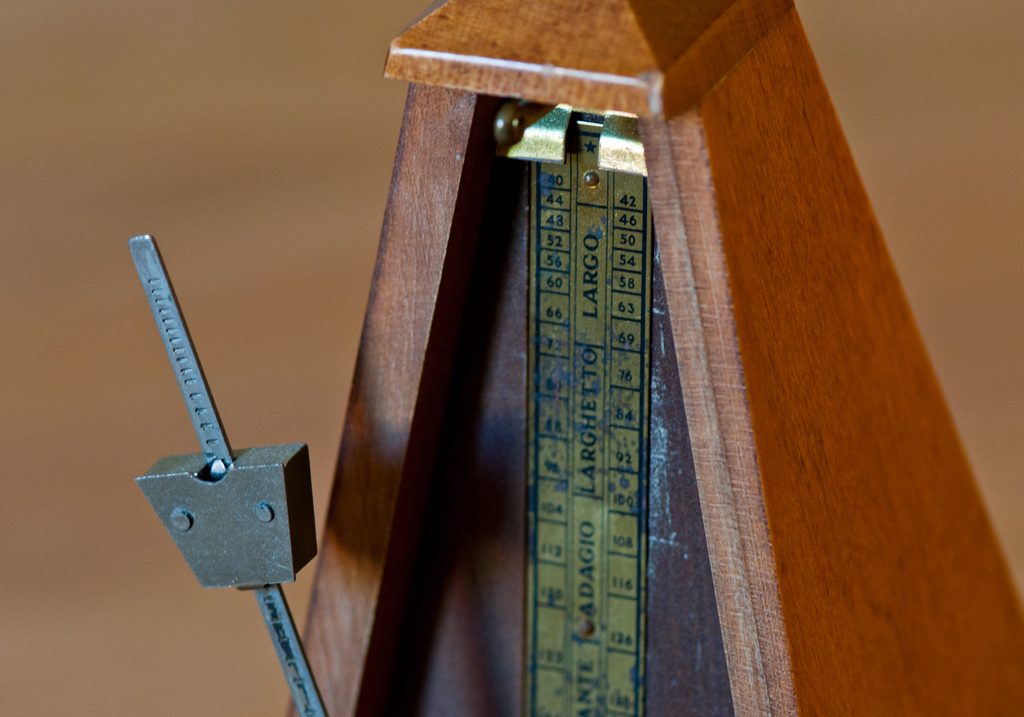By now, I am sure you know the importance of practicing with a metronome. As drummers/percussionists we are supposed to have good time. But, do you just practice with your metronome or do you interact with your metronome during your practice session? It is my belief that most people use their metronome as a listening devise and I want to advocate the use of a metronome as an accompaniment partner. In this article, I will describe the two ways we use a metronome and offer exercises to help improve your timing while using a metronome.
There are many different metronomes and they come in all shapes and sizes. The two most popular, fully featured metronomes are Roland’s Dr. Beat and Tama’s Rhythm Watch, but there are many other devises ranging in price from $15 – $170. If you are an iPhone/iPod Touch owner, check out the metronome review article I wrote back in September. It really doesn’t matter which metronome you own, but you need to make sure you have one and you use it regularly.
The metronome is a listening devise and a timing devise.
The biggest problem is that most people use the metronome only as a listening devise. Now, don’t get me wrong, we all need to be able to listen to a metronome and be able to play with it. This is especially important in a studio setting when we have a click track that is used to sync the musicians with the music or soundtrack. But, have you ever turned off your metronome and not been able to play in time or with a steady pulse? The reason for this is because you have only developed your listening skills.
In order to effectively work on your timing skills, you need to add space between the metronome clicks. If the metronome clicks on every beat you are only working on your listening skills.
Strategies for Developing Your Timing
Below I have outlined 4 strategies for working on your timing skills. I have also created a exercise sheet which you can download. As you continue to work on your timing, make sure you practice this worksheet at different tempos.
1) Add Space between beats or clicks
- Instead of having 4 clicks in a 4/4 measure, put your metronome on half notes and have two clicks per measure
- Turn the click on just the downbeat of the measure
- Turn the click on the downbeat of every other measure or every 4 measures
2) Moveable Pulse
- If you are using half notes as your pulse, practice with the half notes on 1 & 3 as well as 2 & 4
- If you have one click per measure, move the click to start on beat 2 of the measure instead of the downbeat
- Put the metronome on quarter notes, but when you start your phrase, think of the metronome on the “ands” of the beat instead of the downbeats
3) Subtractive Loops or Patterns
- Program a loop into a sequencer program (GarageBand, Logic, Cubase, etc.) and create a 4 bar loop. On the fourth bar, instead of having a measure of groove, leave it blank
- Next practice with two bars of groove and then two bars of space
4) Put space between your metronome and your instrument
- Put the metronome on the other side of the room with a recording devise. The metronome should be loud enough so that you can hear it when you are not playing. Once you start playing, you should only be able to hear yourself and not the metronome. Play back the performance on your recording devise and listen to how well you performed with the metronome. I have found this approach especially beneficial when practicing excerpts.
It is my hope that this blog post will get you to start thinking about using your metronome as an accompaniment partner instead of always being the dictator (“you will always play on every beat with me”). Use the techniques described in the handout in your warm-up routines and as you begin to break away from always using your metronome as a listening devise. I will be posting a video lesson next week that will demonstrate these techniques and show some examples of how to integrate them into your everyday practice routine.
I am always interested in what you have to say about how you use your metronome in your daily practice routines. What percentage do you use your metronome in your practice session? Do you have any specific timing exercises to recommend? Please leave your thoughts and comments below.
Originally posted on DrumChattr on October 8, 2010 by Dave Gerhart.
—–
The photo in this post is used under the Creative Commons License: Attribution – NonCommercial – No Derivs 2.0 by James Lee on Flickr.com.
- 3 Tambourine Strokes Every Percussionist Needs to Know - 03/07/2024
- Mihaly Csikszentmihalyi – Flow - 10/30/2021
- Percussion Education Reads 10/26/21 - 10/26/2021


